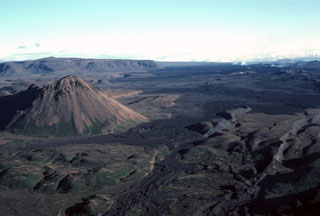Report on Krafla (Iceland) — May 1978
Scientific Event Alert Network Bulletin, vol. 3, no. 5 (May 1978)
Managing Editor: David Squires.
Krafla (Iceland) Deflation event likely this summer; probability of accompanying eruption increasing
Please cite this report as:
Global Volcanism Program, 1978. Report on Krafla (Iceland) (Squires, D., ed.). Scientific Event Alert Network Bulletin, 3:5. Smithsonian Institution. https://doi.org/10.5479/si.GVP.SEAN197805-373080
Krafla
Iceland
65.715°N, 16.728°W; summit elev. 800 m
All times are local (unless otherwise noted)
"Inflation continued in the Krafla caldera at a similar rate as before, with an estimated magma inflow of about 5 m3/s. In a recently published prediction by the geologists working in the area the following points were made:
"A. Timing of the next deflation event: If inflation continues at the present rate, the ground level reached before the last three deflation events will be reached by 20 June. If inflation slows when this level is approached, as has often happened, the last week of July is the likeliest deflation date. Experience shows that once this level is reached, new events may come immediately or after a maximum delay of 2 months.
"B. Location of the next rifting: Large parts of the fault swarm have already been rifted. There are, however, two segments that still have not been rifted or where lesser rifting has been noted. One is a 10-15 km-long segment centered 20-25 km N of the caldera center. The other is the S part of the fault swarm, from 15 km S of the caldera center onwards.
"C. The probability of a lava eruption: The rifting is most likely approaching its final stages. The flow of magma into the holding chambers beneath the caldera continues at a constant rate. The probability of a basaltic lava eruption is therefore increasing."
Geological Summary. The Krafla volcanic system in the Northern Volcanic Zone (NVZ) of Iceland is about 100 km long, consisting of a fissure swarm and a central volcano with a 7 x 9 km caldera formed about 110,000 years ago that deposited a rhyolitic welded tuff. It has been moderately active in the Holocene, over three distinct eruptive periods; the current one has lasted about 2,800 years with six volcano-tectonic episodes, each with one or more basaltic fissure eruptions. Lava volumes (DRE) have been in the 0.1-1 km3 range. The Hverfjall and Ludent tuff rings east of Myvatn were erupted along the fissure system. Myvatn lake formed during the eruption of the older Laxarhraun lava flow from the Ketildyngja shield volcano of the Fremrinamur volcanic system about 3,800 years before present (BP); The present Myvatn lake is constrained by the roughly 2,000 years BP younger Laxarhraun lava flow from the Krafla volcanic system. The abundant pseudocraters that form a prominent part of the Myvatn landscape were created when the younger Laxarhraun lava flow entered the lake. The last eruption took place in 1975-1984 CE when nine small basaltic fissure eruptions produced 0.25 km3 of lava.
Information Contacts: K. Grönvold, NVI.

